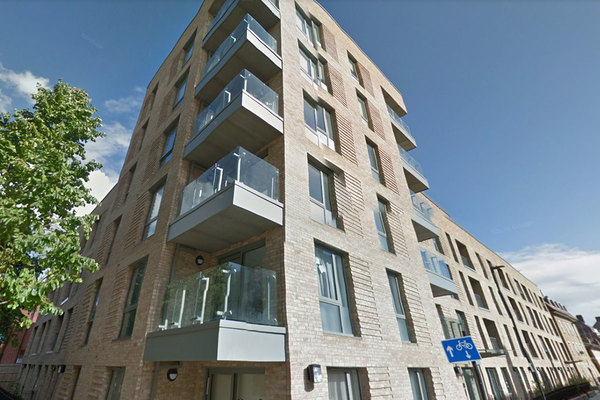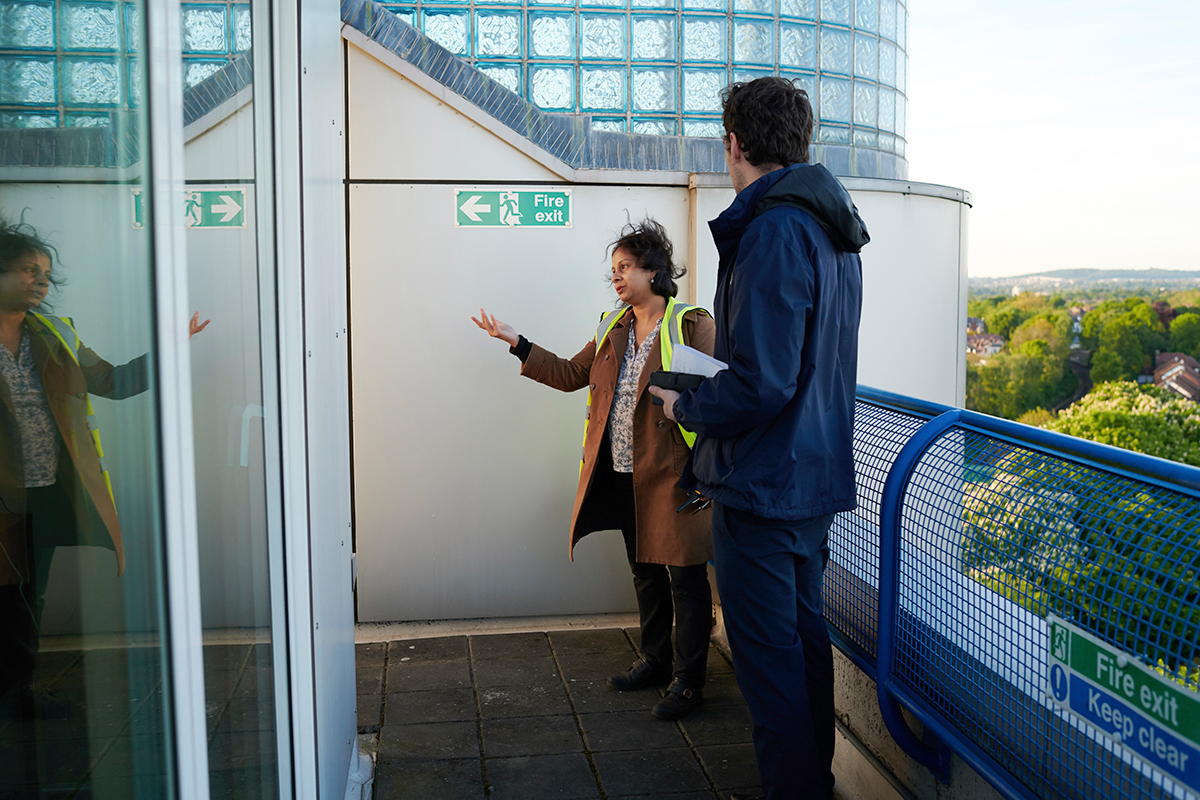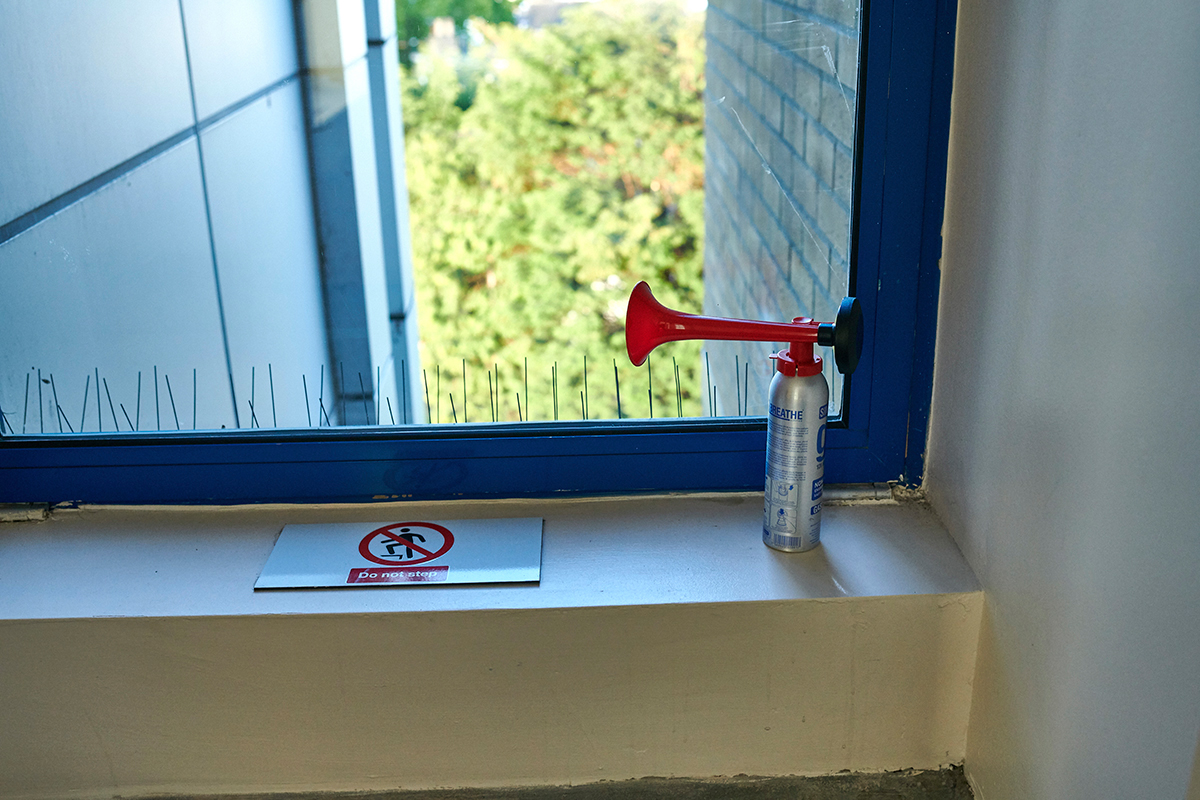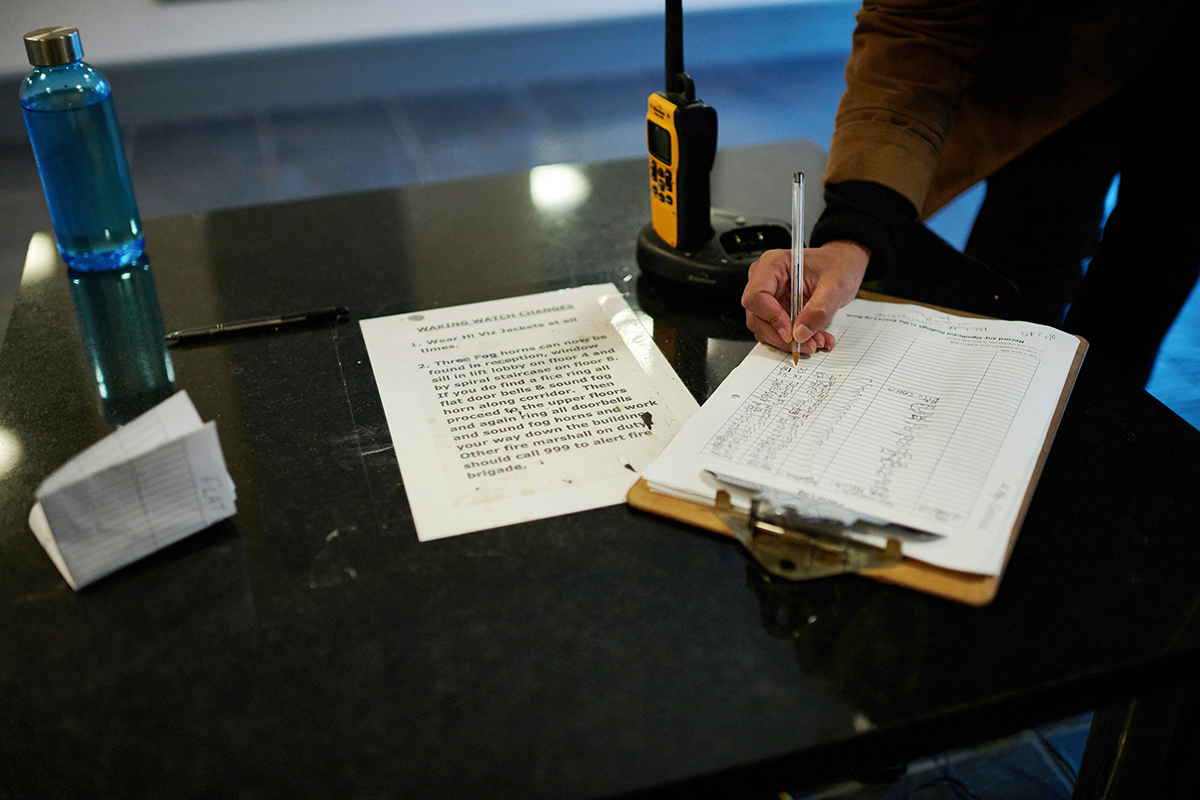The watchers: behind the scenes with the residents doing their own waking watch
With dangerous Grenfell-style cladding still covering hundreds of tower blocks, waking watches have become commonplace. Jack Simpson meets a group of residents who have taken on the grim job themselves. Photography by Dan Joseph
Above: Ritu Saha takes a picture of a fire hazard – a pile of wood in the car park
“How do you keep smiling?” I ask Ritu Saha, as we make our way to the top of the Northpoint apartment block in Bromley, south-east London.
Northpoint is covered in dangerous Grenfell-style cladding. The cladding is one of a number of fire safety issues here – issues that are expected to cost Ms Saha and her neighbours more than £60,000 each to fix.
“If I don’t try and smile, I would cry,” she replies.
It is 8pm on a clear spring evening and we are nearly an hour into Ms Saha’s five-hour patrol of the eight-storey block.
When aluminium composite material (ACM) cladding was discovered on Northpoint in November 2017, the evacuation advice for the block changed from stay put to simultaneous evacuation. That meant that two people had to patrol the building for signs of fire 24 hours a day.
A private company initially carried out the waking watch. But after the £24,000-a-month bill became unaffordable for residents, they decided to do it themselves.
I am here to join Ms Saha on one of her shifts and find out how residents juggle their new commitments with already busy lives.
Her day sounds exhausting: “I left at 7.30am this morning, got home at 6.20pm, and now I’m down here. I haven’t had time to eat.”
Ms Saha is one of six residents covering three waking watch shifts today: 7pm to 12am; midnight to 7am; and then a 12-hour shift between 7am and 7pm.
Besides balancing her duties with a full-time job, she is also dealing with the stress that comes from living in a block covered in a deadly envelope.
Northpoint sits in the centre of Bromley, a leafy suburb on the Kent-London border. As we reach the building’s roof, we stop to watch the sun setting over central London 11 miles away.
“It’s a lovely sunset from here – it’s a shame it’s a living hell for us,” she says.
Since the Grenfell fire, the use of waking watches has proliferated.
Dangerous ACM cladding has been found on 333 high-rise residential buildings. This doesn’t include many more blocks where dangerous combustible non-ACM has been identified as a hazard.
Evacuation instructions on these blocks have changed in line with Northpoint. As a result, installing a permanent waking watch or an alarm system has become mandatory. Of these, waking watches are quicker to implement and cheaper, at least in the short term.
Nearly two years after Grenfell, they are still in place in many buildings.
In Manchester alone, there are 65 blocks with interim measures, and 26 of them use a waking watch.
In London, 209 residential buildings have changed from stay put to evacuation. There is no breakdown on how many of these use a waking watch.
Out on the roof terrace with views of London and Kent
Official guidance from the National Fire Chiefs Council (NFCC) clearly states that a waking watch should only be a temporary solution.
An NFCC spokesperson tells Inside Housing that in all cases remediation is the best option, and that a waking watch should be considered an interim measure as remediation work takes place. Yet on blocks like Northpoint, where disagreements over who will foot the cladding bill have slowed down remediation, waking watches remain.
Unable to return to India where their families are from due to a lack of funds and with the prospect of paying extortionate holiday rates to contractors, the Sahas spent Christmas patrolling the eight uniform corridors.
“Me and my husband did a 12-hour waking watch shift on Christmas Day,” recalls Ms Saha, as we make our way down from the roof to the seventh floor.
Outside one door, we pass a doormat carrying the apt message: “Enter at your peril”. Since the Northpoint block was converted from offices to flats in 1999, it has become a house of horrors in terms of fire safety.
“Me and my husband did a 12-hour waking watch shift on Christmas Day,” Ritu Saha, resident, Northpoint
Ms Saha details myriad fire safety issues, from missing firestops, to “fire-resistant” doors made out of plywood.
The block’s fire consultant – who charges £25,000 for fire safety advice – has estimated it would cost £500,000 to make the inside of the building safe. This is in addition to the re-cladding bill estimated at between £2.5m and £3.2m, and the thousands of pounds already paid for waking watches.
Northpoint building from the street
Ms Saha describes the day in January 2018 when her neighbour knocked on residents’ doors and told them about how much a waking watch was costing them.
“Some people broke down and cried,” she recalls.
The waking watch bill was initially £24,000 a month. By carrying out duties themselves, the costs have now been reduced to £14,000 a month. Residents are still paid minimum wage for their services, and contractors have to be brought in when shifts can’t be filled.
“In any other industry looking at risk mitigation, you wouldn’t come up with a solution that costs a billion pounds,” says Ms Saha.
Inside Housing has spoken to a number of people from blocks that have had to fork out thousands for waking watches. At the Paddington Walk development in central London, leaseholders paid £21,000 per month for a waking watch over a 10-month period.
In some cases, there seems to be very little transparency over these costs. Inside Housing spoke to one resident, living in a Sheffield block, whose property manager charged £2,000 per week for the service.
“Some people broke down and cried,” Ritu Saha, resident, Northpoint
When the property manager was replaced by residents, the new company was able to reduce this to just £452 a week.
However, while the waking watch is a costly solution, the alternative could be worse for residents.
One fire service source tells Inside Housing that while a waking watch is not the “perfect answer, as it is at risk of human error”, the alternative is that buildings become prohibited and residents are moved out.
NFCC guidance for simultaneous evacuation states that a common fire alarm can be used instead of a waking watch, but these can be costly.
Paddington Walk’s alarm cost leaseholders £263,000 to install. Northpoint is also currently looking to have a fire alarm system installed, which Ms Saha says could cost them approximately £119,000.
The block’s lobby has become a waking watch control room. Walkie-talkies sit on a coffee table next to a log book, where every patrol is recorded. On the windowsill is an air horn, to be used in the event of an evacuation. Every hour the two residents on patrol duty hand over.
Hayley Kennedy, tonight’s other waking watcher, sits beside us. The 35-year-old does between three and five five-hour shifts every week, on top of a full-time job.
She is also managing a condition which means she is losing her sight. She does the watch to help pay her service charge bill.
End Our Cladding Scandal: campaign aims
- Government provides a fund to cover the cost of cladding removal and remedial works on private blocks
- A firm timescale is set out of no more than two years for the work to be carried out
- Residents are reimbursed for the interim fire safety costs incurred, and funding is to be provided for necessary internal fire safety measures identified by a competent fire risk assessor
An air horn to be used during evacuation
“I’m single, living by myself and having to fork out these extortionate sums,” she says, explaining how the patrols, which she has been doing for 10 months, have taken over her life.
I ask Ms Saha about training. “There is no formal training that we know of,” she replies.
The need for waking watches post-Grenfell has seen a new industry form overnight. Look across the UK’s high rises and you will find companies, never previously associated with fire safety, providing services.
From construction businesses to security firms, and even a bailiff company, many have taken advantage of the opportunity.
Northpoint uses its cleaning company to fill gaps in its watch rota.
There are concerns that the rate of growth of waking watches has led to poor service in some cases.
The NFCC guidance stresses that waking watch operatives should receive specific fire training, with appropriate equipment.
But while the NFCC guidance is there, it is ultimately the responsible person, which in most cases is the building owner, that has to follow it.
One local government housing expert tells Inside Housing that they doubt many people involved in waking watches have actually read that NFCC guidance.
“The quality does really vary. There are some building owners that are providing reasonably
expensive training or hiring people who are trained, but that is the minority of cases – in many cases the service is appalling,” they say.
They add that there is a discrepancy between the social and private housing sectors, with the performance of the former generally better.
Inside Housing has heard a number of stories of private waking watch staff members not turning up to shifts, or falling asleep on the job.
One resident of a block in south London told Inside Housing about an incident during the football World Cup last year, when they found waking watch staff watching a match instead of working.
While, thankfully, another Grenfell-style disaster hasn’t happened, there have been fires in blocks with waking watches.
The log book, which documents every patrol, and a walkie-talkie
One resident says they only discovered that there had been a fire the next day, when a colleague at work asked him about it.
Pemberstone, the building’s owner, says all systems including the waking watch had worked correctly, and the fire service was satisfied.
To ensure building owners are meeting NFCC guidance, fire services make unannounced visits to blocks. If the fire service deems the waking watch inadequate, it has the power to take enforcement action against the responsible person.
Inside Housing understands that these checks have at times revealed bad practice, but in most cases an informal warning has improved performance. However, more serious steps can be taken if there is no improvement.
Greater Manchester Fire and Rescue confirmed that it has served two enforcement notices requiring improvements by the building’s responsible person.
The responsible person at Northpoint is Northpoint (Bromley) Management Company, a group made up of directors that are also leaseholders. This means that directors, like Ms Saha, are responsible for the fire safety and waking watch on the building, something she says adds extra pressure.
As we reach the roof for the second time, Ms Saha points out a house 400 metres away. When she and her husband first came to Bromley to look for a flat, that was the property they were interested in.
On a whim, they took a look at the Northpoint flat. Seeing the impressive views of London on one side and rolling fields of Kent on the other, they decided to buy. Now, at the start of every patrol, she is reminded of what could have been.
After descending the eight identical corridors once again, the second patrol comes to an end.
It is the last for me, but for Ms Saha and Ms Kennedy there are still three more cycles to go tonight. Ms Saha is on again on Thursday night, Ms Kennedy is down to do Tuesday, Saturday and Sunday night.
“This is so exhausting. You get to 11 o’clock and think when will this end?” Ms Saha tells me with anguish on her face. “We have invited [housing minister] Kit Malthouse to do this, but he hasn’t come yet.”
I say my goodbyes and return home to have dinner, and go to bed just before midnight.
At the same time in Bromley, Ms Saha will be handing over duties to her neighbour, Rachel Guy, and another seven-hour waking watch shift begins.
- Martin Hilditch, editor, Inside Housing
- Manchester Cladiators
- UK Cladding Action Group
- Natasha Elcock, chair, Grenfell United
- Sadiq Khan, mayor of London
- Kate Henderson, chief executive, National Housing Federation
- Terrie Alafat, chief executive, Chartered Institute of Housing
- Andy Burnham, Mayor of Greater Manchester
- Lord Gary Porter, chair of the Local Government Association
- Polly Neate, chief executive, Shelter
- Jane Duncan, chair of the expert advisory group on fire safety, RIBA
- Andy Dark, assistant general secretary of the Fire Brigades Union
- Christina McAnea, assistant general secretary, UNISON
- Sir Peter Bottomley, Conservative MP and chair of the All-Party Parliamentary Group on Leasehold and Commonhold Reform
- Jim Fitzpatrick, Labour MP, and member of All-Party Parliamentary Group on Leasehold and Commonhold Reform
- Mark Amesbury, shadow employment minister and Labour MP for Weaver Vale
- Emma Dent Coad, former Labour MP for North Kensington
- Lucy Powell, Labour MP for Manchester Central
- Rushanara Ali, Labour MP for Bethnal Green and Bow
- George Howarth, Labour MP for Knowsley
- Graham Stringer, Labour MP for Blackley and Broughton
- Rob Ellis, presenter, Capital FM
- John Biggs, mayor of Tower Hamlets
- Paul Dennett, mayor of Salford
- Suzanne Richards, councillor and executive member for housing and regeneration on behalf of all Manchester's Labour Councillors
- Sir Richard Leese, Labour councillor and leader Manchester City Council
- John Leech, Manchester Liberal Democrat leader on behalf of all Manchester’s Liberal Democrat councillors
- Darren Rodwell, executive member for housing at London Councils and leader of Barking and Dagenham Council
- George Clarke, TV Architect
- David Walker, bishop of Manchester
- Graham Tomlin, bishop of Kensington
- John Roberts, founder of AO.com
- Josh Beaumont, professional rugby player, Sale Sharks and resident of affected building
- Bill Beaumont, former England rugby captain
- Jeremy Dyson, co-founder of the League of Gentlemen
- Andy Moss, actor who has appeared on Channel 4’s Hollyoaks and resident
- Ross Mullan, actor who has appeared in Game of Thrones
- Get Cape Wear Cape Fly, musician
- Nour-eddine Aboudihaj, spokesperson for Justice4Grenfell
- Mike Leonard, chief executive, Building Alliance
- Kate Kendrick, founder, National Leasehold Campaign
- Martin Boyd, chair, Leasehold Knowledge Partnership
- Paula Higgins, chief executive, HomeOwners Alliance
- Mark Henderson, chief executive, Home Group
- Ben Clay, founding member of the Tenants Union
- Hilda Palmer, acting chair of the Hazards Campaign
- Susan Bright, professor of law, University of Oxford
- Gill Kernick, consultant and former Grenfell Resident
- Phil Murphy, fire safety expert and tower block resident
This list will be updated. Please email peter.apps@insidehousing.co.uk if you want to support the campaign
End Our Cladding Scandal: full coverage
- Government-funded advice agency tells leaseholders they are 'likely' to be liable for cladding costs: LEASE, the government's official advisory service for leaseholders, has been advising residents they are likely to be liable to pay bills for cladding removal
- Residents evacuated after fire at block with Grenfell-style cladding: Residents of Vallea Court in Manchester are forced to flee after a fire breaks out in a lift shaft
- Leaseholders in London block pay nearly £3.5m for cladding removal: Despite promises from ministers to protect leaseholders, residents of the M&M Buildings near Paddington have been told to pay out
- Minister's will have blood on their hands if another death occurs, says MP: A round-up of the parliamentary debate on providing funding to remove dangerous cladding
- Sector leaders call for an end to the cladding scandal: backers of the campaign explain why they are calling on the government to end the scandal
- #EndOurCladdingScandal – campaign launch sees cladding stories go viral: a round-up of the Twitter reaction to the launch of our campaign
- Revealed: the mental health trauma of residents in blocks with dangerous cladding: read about the mental health impacts of dangerous cladding on high rises
- Victims of the cladding scandal: read the stories of some of those impacted by the crisis
- Why we need a cladding fund for private buildings: Manchester Council chief executive Joanne Roney explains why a fund to pay for cladding removal is necessary
- Why Inside Housing is joining with leaseholders to call for an end to the cladding scandal: our deputy editor Peter Apps on why we are supporting the campaign
- End our cladding scandal: the campaign’s aims and backers


















